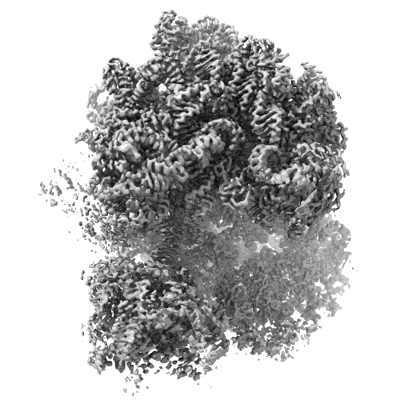EMD-13241
E. faecalis 70S ribosome bound by PoxtA-EQ2, high-resolution combined volume
EMD-13241
Single-particle2.4 Å
 Deposition: 20/07/2021
Deposition: 20/07/2021Map released: 23/02/2022
Last modified: 16/10/2024
Sample Organism:
Enterococcus faecalis
Sample: Complex of PoxtA-EQ2 bound to the 70S ribosome from E. faecalis (initiation complex), state I.
Fitted models: 7p7q (Avg. Q-score: 0.572)
Raw data: EMPIAR-10764
Deposition Authors: Crowe-McAuliffe C ,
Wilson DN
,
Wilson DN 
Sample: Complex of PoxtA-EQ2 bound to the 70S ribosome from E. faecalis (initiation complex), state I.
Fitted models: 7p7q (Avg. Q-score: 0.572)
Raw data: EMPIAR-10764
Deposition Authors: Crowe-McAuliffe C
 ,
Wilson DN
,
Wilson DN 
Structural basis for PoxtA-mediated resistance to phenicol and oxazolidinone antibiotics.
Crowe-McAuliffe C  ,
Murina V,
Turnbull KJ,
Huch S
,
Murina V,
Turnbull KJ,
Huch S  ,
Kasari M
,
Kasari M  ,
Takada H
,
Takada H  ,
Nersisyan L
,
Nersisyan L  ,
Sundsfjord A,
Hegstad K
,
Sundsfjord A,
Hegstad K  ,
Atkinson GC,
Pelechano V
,
Atkinson GC,
Pelechano V  ,
Wilson DN
,
Wilson DN  ,
Hauryliuk V
,
Hauryliuk V 
(2022) Nat Commun , 13 , 1860 - 1860
 ,
Murina V,
Turnbull KJ,
Huch S
,
Murina V,
Turnbull KJ,
Huch S  ,
Kasari M
,
Kasari M  ,
Takada H
,
Takada H  ,
Nersisyan L
,
Nersisyan L  ,
Sundsfjord A,
Hegstad K
,
Sundsfjord A,
Hegstad K  ,
Atkinson GC,
Pelechano V
,
Atkinson GC,
Pelechano V  ,
Wilson DN
,
Wilson DN  ,
Hauryliuk V
,
Hauryliuk V 
(2022) Nat Commun , 13 , 1860 - 1860
Abstract:
PoxtA and OptrA are ATP binding cassette (ABC) proteins of the F subtype (ABCF). They confer resistance to oxazolidinone and phenicol antibiotics, such as linezolid and chloramphenicol, which stall translating ribosomes when certain amino acids are present at a defined position in the nascent polypeptide chain. These proteins are often encoded on mobile genetic elements, facilitating their rapid spread amongst Gram-positive bacteria, and are thought to confer resistance by binding to the ribosome and dislodging the bound antibiotic. However, the mechanistic basis of this resistance remains unclear. Here we refine the PoxtA spectrum of action, demonstrate alleviation of linezolid-induced context-dependent translational stalling, and present cryo-electron microscopy structures of PoxtA in complex with the Enterococcus faecalis 70S ribosome. PoxtA perturbs the CCA-end of the P-site tRNA, causing it to shift by ∼4 Å out of the ribosome, corresponding to a register shift of approximately one amino acid for an attached nascent polypeptide chain. We postulate that the perturbation of the P-site tRNA by PoxtA thereby alters the conformation of the attached nascent chain to disrupt the drug binding site.
PoxtA and OptrA are ATP binding cassette (ABC) proteins of the F subtype (ABCF). They confer resistance to oxazolidinone and phenicol antibiotics, such as linezolid and chloramphenicol, which stall translating ribosomes when certain amino acids are present at a defined position in the nascent polypeptide chain. These proteins are often encoded on mobile genetic elements, facilitating their rapid spread amongst Gram-positive bacteria, and are thought to confer resistance by binding to the ribosome and dislodging the bound antibiotic. However, the mechanistic basis of this resistance remains unclear. Here we refine the PoxtA spectrum of action, demonstrate alleviation of linezolid-induced context-dependent translational stalling, and present cryo-electron microscopy structures of PoxtA in complex with the Enterococcus faecalis 70S ribosome. PoxtA perturbs the CCA-end of the P-site tRNA, causing it to shift by ∼4 Å out of the ribosome, corresponding to a register shift of approximately one amino acid for an attached nascent polypeptide chain. We postulate that the perturbation of the P-site tRNA by PoxtA thereby alters the conformation of the attached nascent chain to disrupt the drug binding site.
Secondary citations:
- Crowe-McAuliffe C, Murina V, Kasari M, Takada H, Turnbull KJ, Sundsfjord A, Hegstad K, Atkinson GC, Wilson DN & Hauryliuk V. (2021) Structural basis for PoxtA-mediated resistance to Phenicol and Oxazolidinone antibiotics. bioRxiv,
- Sivertsen A, Janice J, Pedersen T, Wagner TM, Hegstad J & Hegstad K. (2018) The Enterococcus Cassette Chromosome, a Genomic Variation Enabler in Enterococci. mSphere, 3,
